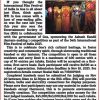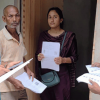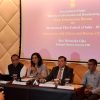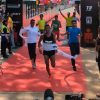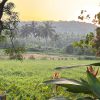Goa is abuzz with excitement as vintage bike and car owners, users, collectors and fans are decking […]
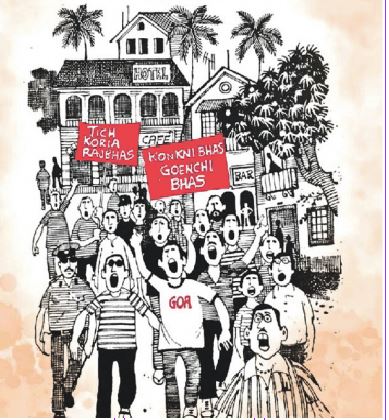
Rajan NarayanMEMOIRS OF AN UNDERDOG JOURNALIST! `I have no sacred cows!’ `I’m the goonda with the pen!” MY TRYST WITH GOA!
June 29- July 05 2024, Life & Living June 28, 2024By Rajan Narayan
I CAME to Goa on October 1, 1983. My mandate was to convert the century-old Portuguese OHeraldo daily into a vibrant English daily. I had to start from scratch as there were no tally printers in Goa which provided news from India and the world. To begin with I had no staff except the news editor S Vaidyanathan who I had brought with me from Mumbai.
However, I was committed to bringing out the English edition of the OHeraldo by November 10, 1983. We went to Miramar beach in the office jeep where the bright students from Dhempe College hung around the beachside. We asked some of them if they would be interested in a career in journalism? I don’t think they knew what journalism is all about but all of them were interested in getting a job. So we hired half-a-dozen of them.
Back in the office my news editor Vaidyanathan taught them what they had to do. I recruited Devika Sequeira as my chief reporter, she had some experience working for magazines in Mumbai. We brought the tally printers from the United News of India (UNI) and the Press Trust of India (PTI). Since I could not function without a secretary I hired a young, very enthusiastic, young woman who was barely 17 years old, Sheryl d’Souza
It is with this small but very enthusiastic team that we launched the OHeraldo daily on October 1, 1983. I had done a thorough study of the Goa market for readership at that time. At that time there was only one English newspaper in Goa, namely “The Navhind Times” and it catered to the Hindu English-reading population. As it was owned by a mining company it always supported the government.
CATHOLICS, NO VOICE
THE Catholics, who comprised almost 40% of the population in 1983, did not have much of a voice. The Catholics were in a majority in the Salcete taluka of south Goa. I targeted the OHeraldo for the Catholic population. This was very well received and it also helped the cash to flow into the newspaper’s kitty. Catholics used to announce the deaths and births of their close kin. These death and birth advertisements had to be paid for in cash. This helped bring revenue to the paper right from the start.
As a matter of policy, we projected ourselves as an independent daily which would be critical of the government. Independent media’s cardinal principle is or used to be you not sleep with the government. In fact, within a month of starting the paper, we had a confrontation with the then chief minister of Goa, Pratapsingh Raoji Rane.
The then director of the Kala Academy was Damu Kenkre, a very prominent theatre personality. The Hotel Federation of India was having its annual meeting in Goa for the first time in November 1983. They asked the Kala Academy choir to perform at the inaugural ceremony. Damu Kenkre choreographed the event and designed suitable costumes for the artistes. Vijaya Devi the wife of the then chief minister visited one of the rehearsals. However, Chief Minister Rane’s wife Vijaya Devi insisted that the participants should wear green sarees and orange blouses, the colors of the national flag.
Damu Kenkre was horrified. Kenkre refused to change the costumes and he was sacked by Chief Minister Pratapsingh Raoji Rane. The CM insisted that his wife had the right to design the costumes of the artistes. A heartbroken Kenkre told me the story at the Clube Vasco-da-Gama. I carried an anchor item under the title “How a dream was shattered because of the color of the saree.”
AC FERNANDES, MY PUBLISHER
THE next day my publisher AC Fernandes got a call from Chief Minister Pratapsingh Raoji Rane, wanting my publisher to sack me. My publisher, a self-made man, told the then chief minister that he would not bow down to the dictates of the chief minister and pointed out that it was he who was paying my salary and not the chief minister. The credit for the success of the OHeraldo should go to AC Fernandes. He was not interested in making money as he was interested in the welfare of the people of Goa. Indeed, every afternoon when he came to visit me in the OHeraldo office he would ask me to fight corruption and promote the wellbeing of people and Goa.
In keeping with our emphasis on investigative journalism, we focused on the murder of three old sisters in Velim in south Goa. We were shocked to discover that they were murdered for property. They had large amounts of property which a lot of people had their eyes on. My chief reporter, Devika Sequeira, discovered that not only police officers but even the local MLA was involved in the murder of the three sisters. The sisters who was in their 80s were very contentious.
OHeraldo ensured that the case was properly investigated and the guilty were punished. We kept following up on the case through investigations and the trial in court, kept up the pressure on the police. This was the kind of journalism which was new to Goa, nobody followed up on major events in those times, preferring to let sleeping dogs lie or something like that.
CHOGM CHALLENGE
WE were very fortunate that the Commonwealth Heads of Government Meeting was held within a month of our starting publication. It took place in November 1983. It was the convention that while the meeting of the Commonwealth heads of state was held at the national capital, the 52 leaders would spend a weekend in a holiday resort so that they could get to know each other better and discuss issues in confidence.
In the run-up to CHOGM the Taj Aguada Hotel decided to create a separate wing called the Hermitage to accommodate the 52 heads of government and heads of state. Amongst those expected in Goa were Prime Minister of the UK Margaret Thatcher and Prime Minister of Canada Pierre Trudeau (the father of the present Canadian prime minister, Justin Trudeau). There were also many African heads of state like Jomo Kenyatta of Kenya. The hostess was Prime Minister of India Indira Gandhi.
The Taj horticulturist waxed eloquent over the floral scheme designed around the villas the visiting heads would be staying in. He told me that Indira Gandhi would be staying in the cottage with the pink flowers, Margaret Thatcher in the cottage of white flowers, every leader could be identified by the color of the flowers around the cottage. We published the story titled: “52 Flowers Will Bloom.”
The next day I had all the CHOGM security people after my blood. They were very upset about my revelation of the detailed floral scheme of the cottages in which the visiting heads of state would be staying. They were worried that if somebody wanted to attack any leader they had only to look at the color of the flowers around the cottage and go for it. Overnight the entire floral color scheme was changed much to the horror of the horticulturist.
Covering CHOGM was a huge challenge with my rookie staff of reporters. Particularly since the world leaders did not limit themselves to the Taj hotel but went around visiting various parts of Goa. We were alerted that President Jomo Kenyatta and his foreign minister would be visiting a small chapel in Merces. An ancestor of the foreign minister had been a priest at the chapel.
Alerted by the Parish priest our team was there to record the event. I recall Devika Sequeira meeting Denis Thatcher, the British prime minister’s spouse at the Old Goa church complex. Devika asked him if he was attending the tea party for the spouses of the CHOGM leaders. Since he was the only male spouse he was very irritated with the question.
We managed to get photographs of the dinner hosted by Indira Gandhi for the 52 leaders. Including, a recording of a love song by Jomo Kenyatta. The Kenyan president revealed that he had courted his wife with this song. Perhaps our major achievement was that we managed to get photographs of all 52 heads of state. We published all the photographs and this was of enormous use for the security personnel.
I recall one very unpleasant incident. One of the foreign ministers who was staying at Cidade-de-Goa, told our young reporter Cheryl D’souza to meet him at the hotel at 10 pm at night, promising her scoop. I insisted on accompanying Sheryl to the hotel. He asked her to come to his room and when Cheryl knocked at the door the minister himself opened the door in his dressing gown, and in the course of talking to her propositioned her. Cheryl spoke to me and I instructed her to leave the room immediately. Even the foreign media appreciated our coverage of CHOGM in Goa in OHeraldo.
TURNING POINT
OF COURSE, the turning point for OHeraldo was when the Konkani agitation took place. In 1985, MLA Luizinho Falerio passed a resolution to make Konkani the official language of the state. This was defeated by the Chief Minister Pratapsingh Raoji Rane-led Marathi lobby. I sensed that this was a major issue or concern to all Goans. There was a latent desire for mai bhash to be raj bhash.
A small group of Konkani writers formed the Konkani Ponjeche Awaz which means “Voice of the Konkani People.” We carried a cartoon of Konkani-mai in a coffin with the caption “Konkani Mai Mele.” This was the spark that was needed. The whole of Goa rose to join the battle to make Konkani the official language of the state. It was a long, hard battle.
The then editor of the Marathi paper Gomantak, Narayan Athawale, insisted that Marathi should be made the official language. For almost two years I wrote front-page editorials under the title “Utt Goenkara.” The slogan was “Amche Mai Bhash, Amche Raj Bhash.” Initially, all the Catholic politicians and prominently Luizinho Falerio, Churchill Alemao and Dr Wilfred d’Souza, joined the agitation.
Subsequently, even the Hindu leaders like Harish Zantye joined the battle for the recognition of Konkani as the state language. The moment of triumph for the OHeraldo campaign was when more than one lakh people turned up for the rally to demand official language status for the Konkani the Azad maidan in Panaji.
Not only Konkani writers but Konkani artistes including Remo Fernandes took part in the rally. After the rally, there were blockages of the streets, huge morchas and campaigns throughout Goa, calling for making Konkani the official language of Goa. Finally, the Congress High Command, Prime Minister Rajiv Gandhi directed Chief Minister Pratapsingh Raoji Rane to move a bill for declaring Konkani as the official language of the state.
The bill was passed in February 4, 1987. Soon after that Goa was conferred statehood on May 30 the same year. Till Goa got its own official language bill it could not have become a state. This is because states in the country were formed on the basis of the official language.
It is perhaps regrettable that Romi script Konkani was not given official language status. I recall that one day after the bill was passed an angry Churchill Alemao barged into my office at OHeraldo insisting that we should claim that Konkani mai was betrayed. I personally felt that the bill being passed alone was a bigger victory and it could be subsequently be amended to give Romi Konkani equal status with Devnagiri Konkani.
The tragic part is that Pratapsingh Raoji Rane’s Congress government sabotaged the Konkani bill by stipulating that Marathi would be used for any or all official purposes. It is from the point of view of the newspaper that the victory of the Konkani battle which established OHeraldo as the most influential paper in Goa. It was here to stay.
